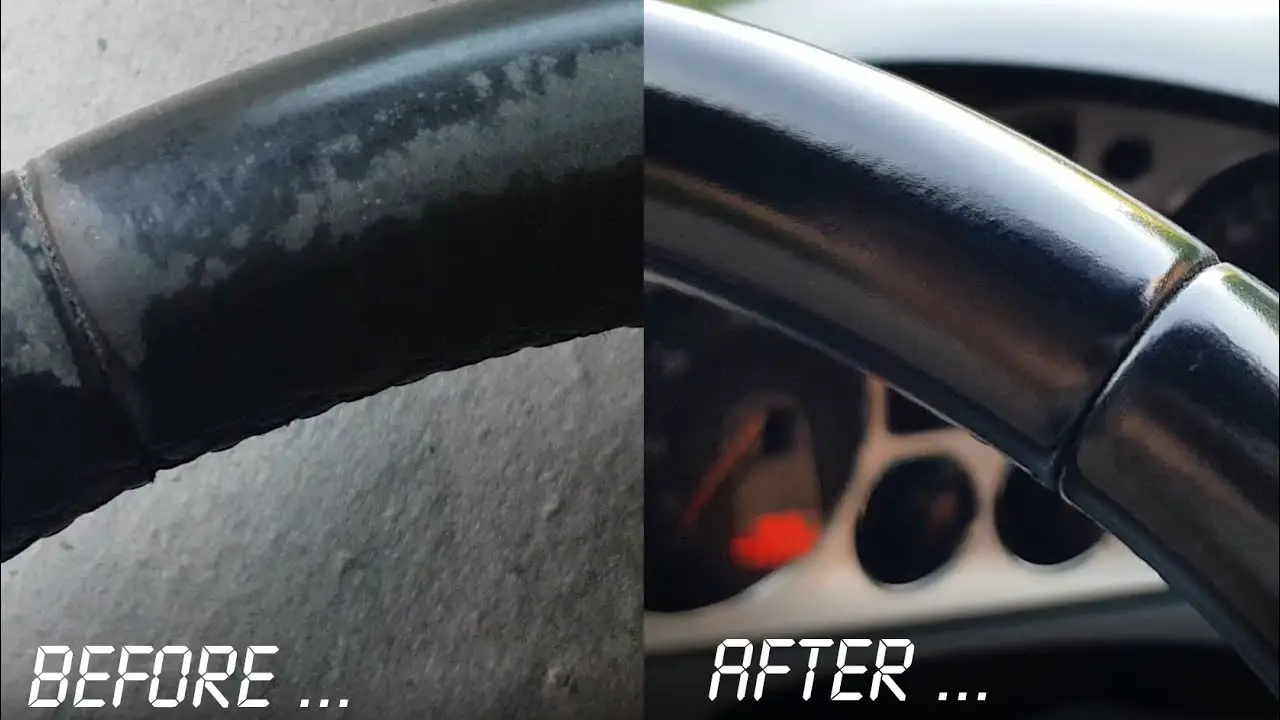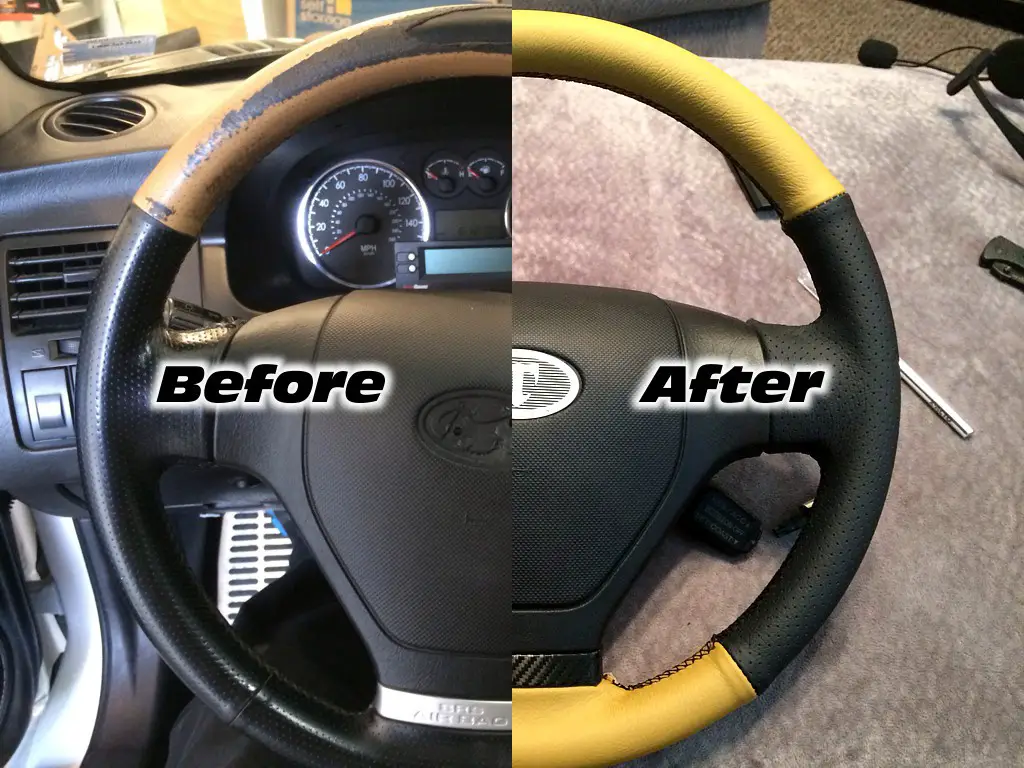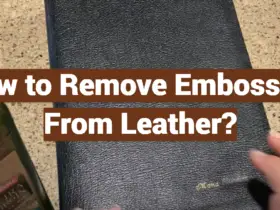Leather steering wheels can make your driving experience better. Not only do they look great, but they also provide a more comfortable grip. Over time, however, leather steering wheels can become worn and faded. If this happens to your steering wheel, don’t worry – you can restore it yourself! In this article, we will discuss the steps necessary to restore your leather steering wheel to its former glory.
What’s Wrong with Your Steering Wheel?

Before beginning the restoration process, you will need to assess what is wrong with your steering wheel. If it’s just dirty or faded, it can be restored relatively easily. However, if the leather has been damaged or cracked, a more involved repair may be necessary. Additionally, some leather steering wheels have a plastic coating over them that can become brittle and break over time. In this case, you will need to either replace the entire steering wheel or have it professionally re-covered. [1]
Restore A Dry and Cracked Steering Wheel
If your steering wheel has become dry and cracked, you will need to rehydrate it. Begin by cleaning the wheel with a damp cloth. Then, purchase a leather cleaner/conditioner specifically designed for automotive interiors. Follow the instructions on the bottle and apply liberally to the entire wheel. This should help restore some of its natural suppleness and shine.
Once finished, take some wax paper or plastic wrap and cover the wheel completely to protect it while drying. Finally, allow the wheel to dry overnight before driving again.[2]
Materials You Need
If your leather steering wheel has become worn and faded, you will need the following materials:
- Leather cleaner/conditioner
- Soft cloths or sponges
- Mild soap
- Protective wax paper or plastic wrap
- Leather dye (optional)
- Remove The Steering Wheel
Before you begin restoring your leather steering wheel, it must first be removed from the vehicle. This process can vary depending on the make and model of your car so it is important to follow the instructions in your owner’s manual or consult a professional mechanic.
Clean Meticulously
Once the steering wheel is removed from the car, begin by cleaning it thoroughly. Use a mild soap and water solution to remove any dirt or debris from the leather surface. If necessary, you can also use a soft brush or light sandpaper to scrub away stubborn stains.
Coat With Leather Restoration Oil
After the wheel is clean, you will need to apply a leather restoration oil. This product helps restore the natural oils in the leather that have been lost over time. Use a soft cloth or sponge to spread the oil onto the steering wheel, making sure to cover every inch of it. Allow the oil to sit for at least 8 hours before moving on to the next step. [3]

Clean Again and Prep
Once the oil has been allowed to sit, wipe down the steering wheel with a clean cloth. This will help remove any excess oil and prepare the leather to accept dye. If you plan on dying your steering wheel, proceed to the next step.
Fill Cracks and Scratches With Filler
If the leather has become cracked or scratched, you will need to fill these areas with a leather filler. This product is designed to fill in any imperfections and make the surface smooth and even again. Once finished, use a clean cloth to wipe away any excess filler.
Sand Smooth With Fine Sandpaper
Once the filler has been applied and dried, you can begin sanding it down. Use fine-grit sandpaper to gently buff away any rough or uneven spots. This will create a smooth surface that is ready for dyeing or polishing.
Apply the Leather Dye
If you wish to add color to your steering wheel, now is the time. Use a leather dye specifically designed for automotive interiors and apply it in thin layers until you achieve the desired hue.
Allow each layer to dry completely before adding more.
Install a Custom Steering Wheel Cover
If you are looking to add an extra bit of flair to your steering wheel, consider installing a custom cover. These covers come in a variety of colors and styles and can be tailored to fit almost any shape or size. They are easy to install and will help protect the leather from wear and tear over time.

Install Your Custom Cover
Once the leather has been restored and dyed, you can move on to the installation process. Follow the instructions that came with your cover and use a damp cloth to clean any dust or debris from the steering wheel before attaching it. Securely fasten all clips or straps and make sure that the cover is evenly fitted before driving again.
Reupholster A Leather Steering Wheel
If your leather steering wheel needs a more drastic makeover, you may want to consider reupholstering it. This process is somewhat more involved than simply restoring or dying the leather but can be well worth the effort if done correctly.
Materials You Need
To reupholster a leather steering wheel, you will need the following items
- Leather or vinyl upholstery material
- Scissors or sharp knife
- Heavy-duty thread
- Staple gun and staples
- Leather restorations oil/conditioner
- Soft cloths or sponges
- Mild soap
- Protective wax paper or plastic wrap
- Remove the Steering Wheel
The first step is to remove the steering wheel from the car. Refer to the section above for more detailed instructions on how to do this safely and properly.
Remove the Old Leather Wrap
Once the wheel is off, you can begin to remove the old leather wrap. Use a pair of scissors or a sharp knife to carefully cut away the material. Discard any remaining pieces and clean any excess glue from the surface with a mild soap and water solution.
Use the Old Wrap as a Template
Before you can install the new leather wrap, you will need to create a template. To do this, use the old wrap as a guide and trace it onto some wax paper or plastic wrap. Cut out the shape with scissors and set it aside for later.
Trim the Leather to Fit
When you have your template, use it to cut out a piece of leather that is slightly larger than the shape. This will give you some extra room to work with when fitting the leather onto the wheel.
Trim off any excess material and test fit the leather to make sure it sits correctly.
Mark Your Sewing Lines
Once you have the leather properly fitting on the wheel, mark any necessary sewing lines with a marker or pen. This will help you to keep track of where to sew and make sure that your stitching is even throughout.
Saw the Cover Over Your Wheel
Starting at one end, begin to sew your leather cover onto the wheel. Use a heavy-duty thread and proceed slowly as you work your way around. Once all of your seams have been secured, use a staple gun to attach the edges of the material securely.
Steering Wheel Maintenance Tips
To keep your newly upholstered steering wheel looking great, be sure to follow these maintenance tips.
Clean the wheel regularly with a soft cloth or sponge and a mild soap solution.
Use leather restoration oil periodically to condition and protect the material.
Avoid direct sunlight as much as possible to prevent fading or cracking.
Never use harsh chemicals or cleaning agents on the wheel. [4]
FAQ
How do I make my old steering wheel look new?
The best way to make an old steering wheel look new is to restore or reupholster it. To restore the leather, clean and repair any damaged areas before applying a dye to achieve a uniform color.
To reupholster the wheel, you will need to remove the old leather wrap and use it as a template to cut out a piece of new material that fits your steering wheel. Once the leather has been fitted onto the wheel, sew or staple it in place for a secure fit.
How much does it cost to restore a steering wheel?
The cost of restoring a steering wheel can vary depending on the type of leather and dye used, as well as any additional materials or tools needed. Generally speaking, you should expect to spend between $400 – $1000 to restore an average-sized leather steering wheel. If you choose to reupholster the wheel with new material, that cost may be higher. [5]
How often should the steering wheel be replaced?
The steering wheel should be replaced when it is showing signs of wear and tear, such as fraying or cracking of the leather. If the wheel has been heavily damaged, it may need to be replaced sooner rather than later. It’s important to inspect the wheel regularly for any potential issues and take action immediately if necessary. In addition, you should always replace a steering wheel after any serious accidents or collisions that could have caused damage to the material.
How do you restore a shiny leather steering wheel?
To restore a shiny leather steering wheel, you will need to clean off any dirt or debris with a damp cloth. Next, apply a leather conditioner or cleaner to the wheel and rub it in with a soft cloth. Finally, buff the wheel with a dry cloth for an instant shine. You can also use wax polish to give the steering wheel a glossy finish. It’s important to only use products specifically designed for leather, as these are less likely to cause damage or discoloration. Follow all instructions on the product label carefully before using it on your steering wheel.
Useful Video: How to Restore A Leather Steering Wheel
Conclusion
Taking care of leather steering wheels is essential in order to keep them looking great and functioning properly. Learning how to restore a leather steering wheel is relatively easy, but it does take time and patience for the best results. If you follow these steps, such as cleaning the surface with a soft cloth regularly, conditioning and protecting the leather with a quality product, you can avoid any major damage or wear and tear. Remember that if your leather is too far gone, you may need to consider buying a replacement. In conclusion, restoring your leather steering wheel doesn’t have to be complicated – if it’s done right with quality products and attention to detail. So go ahead and think of it as an investment so you can enjoy your leather steering wheel for many years to come!
References
- https://www.torquedetail.com/blogs/car-interior-cleaning/steering-wheel-restoration
- https://rubnrestore.com/how-to/auto-leather-repair/
- https://itstillruns.com/restore-leather-steering-wheel-7443238.html
- https://thescratchdoctor.co.uk/product-category/auto/leather-steering-wheel-repair/
- https://www.steeringwheelbob.com/process-pricing







Leave a Reply